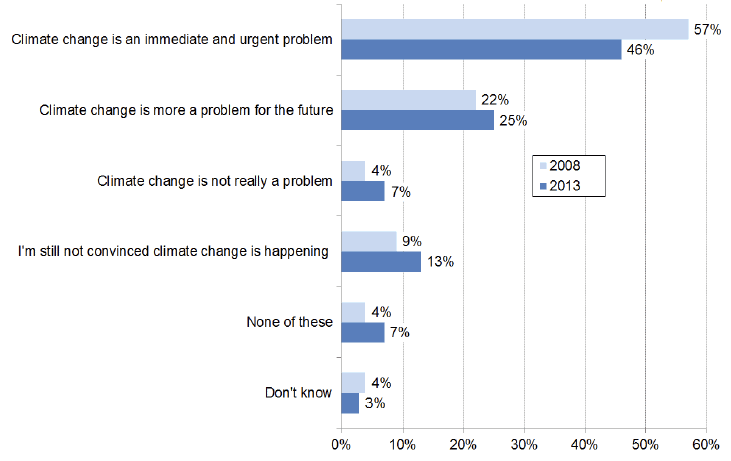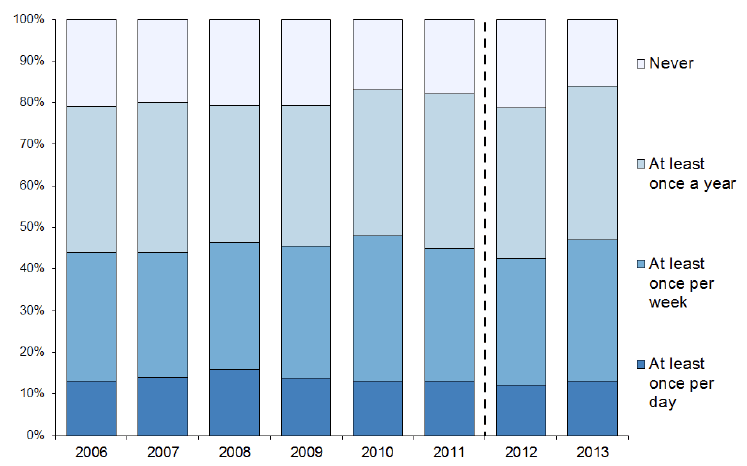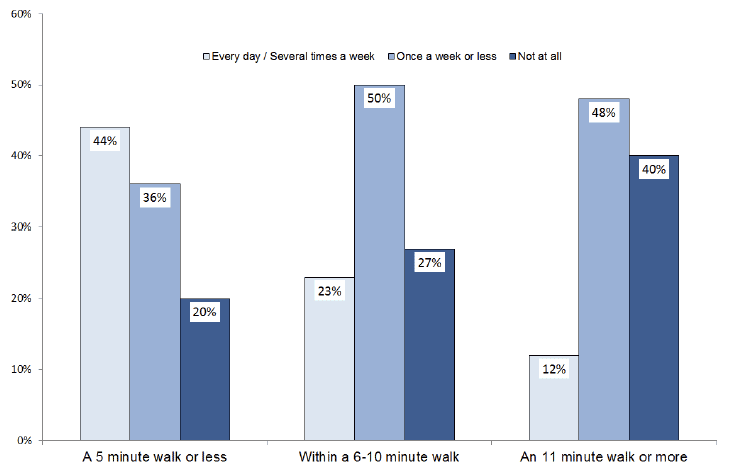Key Scottish Environment Statistics 2014
This publication aims to provide an easily accessible reference document which offers information on a wide range of environmental topics. It covers key datasets on the state of the environment in Scotland, with an emphasis on the trends over time wherever possible. The data are supplemented by text providing brief background information on environmental impacts, relevant legislation and performance against national and international targets.
This document is part of a collection
Public Attitudes & Behaviours
Perceived Immediacy of Climate Change: 2008 and 2013
Which of these views, if any, comes closest to your own view about climate change?

Action to address climate change is a high priority for the Scottish Government, and the Climate Change (Scotland) Act (2009)[1] set targets to reduce Scotland's greenhouse gas emissions. Public attitudes about the immediacy of climate change as a problem for Scotland are likely to influence their willingness to support initiatives to address climate change, including changing their own behaviours. This measure is part of a small set of low carbon attitude and behaviour-related indicators set out in 'Low Carbon Scotland: A Behaviours Framework'[2].
The Scottish Household Survey, 2013, included a question about attitudes towards climate change. The same question had been asked in the Scottish Environmental Attitudes and Behaviours Survey 2008[3], so the results can be compared, although the surveys were slightly different. Respondents were presented with four statements about climate change and asked which, if any, was closest to their own view.
In 2008, 57% of respondents thought that climate change was an immediate and urgent problem, compared with 46% in 2013, a fall of 11 percentage points. The percentage of people who think climate change is a problem for the future increased from 22% to 25%. In contrast in 2008, 13% of respondents considered either that climate change was not a problem or were not convinced it was happening, compared with 20% of respondents in 2013, an increase of seven percentage points.
Source: Scottish Government / Scottish Government / Metadata
Percentage of adults making visits to the outdoors

Outdoor recreation is beneficial for health and well-being. It also provides opportunities for people to come into contact with, and increase their understanding of, the natural environment. Although outdoor recreation has multiple motivations, this indicator provides a useful measure of the numbers of people who gain benefit and enjoyment from nature and biodiversity and improve their understanding and functioning of the natural environment.
The Scottish Government has established a National Indicator[4] to increase the proportion of adults making one or more visit to the outdoors per week. During 2013, 46% of adults are estimated to have made visits to the outdoors one or more times per week, compared to 42% in 2012. For 2012 and 2013, data are taken from the Scottish Household Survey, where respondents were asked how often, on average, they had made a visit to the outdoors for leisure and recreation in Scotland in the last 12 months.
There are a great variety of factors and influences for the level of outdoor recreation which may have affected the number of visits made to the outdoors last year, such as the weather. 2013 was also the Year of Natural Scotland, which aimed to celebrate and promote all of Scotland's outstanding natural beauty, landscapes and biodiversity.
Prior to 2012 the data was sourced from the Scottish Recreation Survey produced by Scottish Natural Heritage, which contained the same question[5].
Source: Scottish Government / Scottish Natural Heritage / Metadata
Frequency of Use of Local Greenspace: 2013
Frequency of use by time to walk to nearest useable greenspace (percentage of adults)[6]

Greenspaces are parks, greens and areas of grass available for people to visit. Within urban areas they are a particularly important part of the Scottish landscape, where they allow people to participate in sports and exercise who would otherwise not have access to suitable spaces. Having easy access to good greenspaces can improve people's quality of life by increasing satisfaction with their neighborhood, promoting mental and physical health (including through its association with increased physical activity), and reducing health inequalities[7].
The Scottish Household Survey collects data on how accessible people's nearest usable greenspace is from their home (measured in terms of the time taken to walk there), and how often they use it. In 2013, 68% of people in Scotland reported that they lived within a 5 minute walk or less of their nearest greenspace, with 19% living within 6-10 minutes of their nearest greenspace. Overall 36% of people said that they visit their nearest greenspace once a week or more, with 40% visiting once a week or less and 24% not visiting at all.
There is a strong link between how far people have to walk to reach their local greenspace and how often they use it. For those living within a 5 minute walk, 44% of people visited their nearest greenspace several times a week. Increasing this to just a 6-10 minute walk this is reduced down to 23%.
Source: Scottish Government / Metadata
Contact
Email: Kirsty Ciclitira
There is a problem
Thanks for your feedback